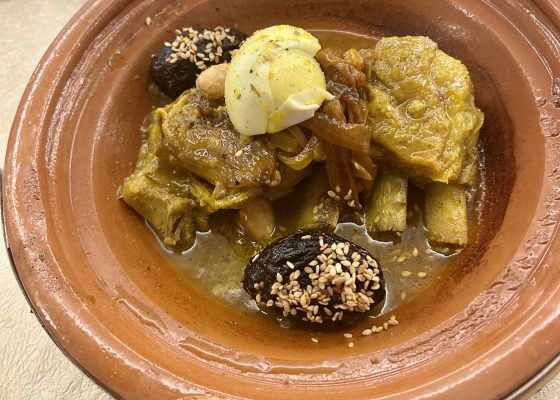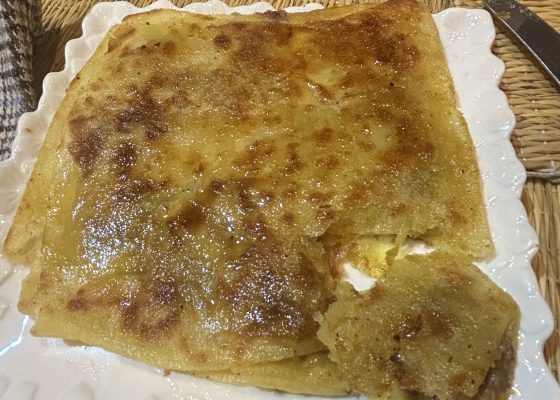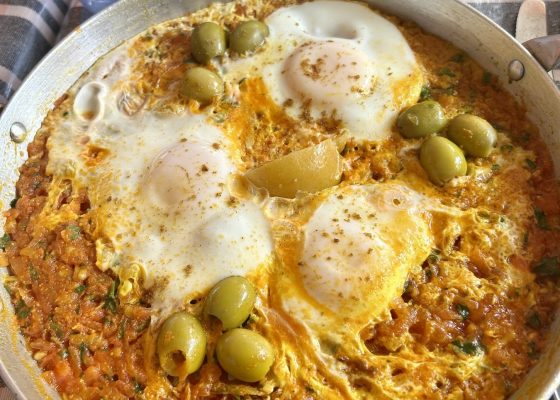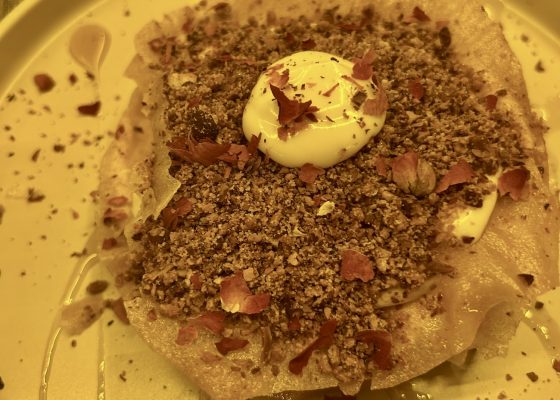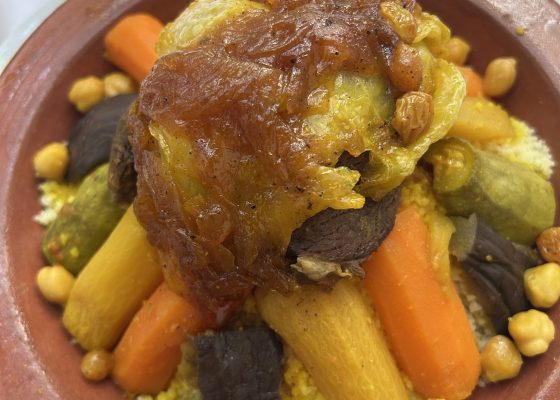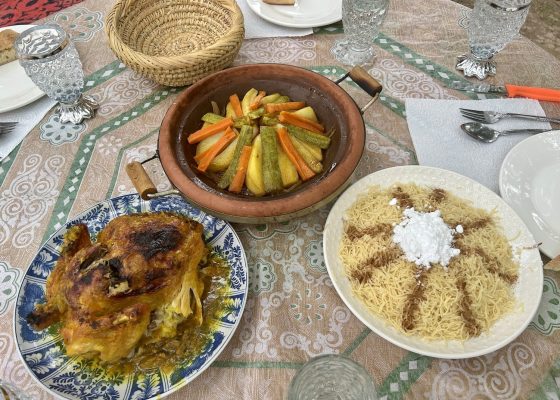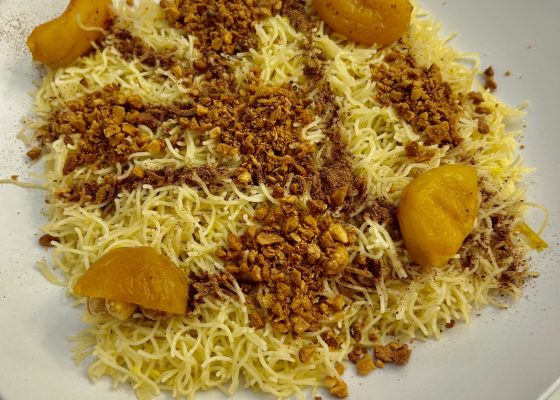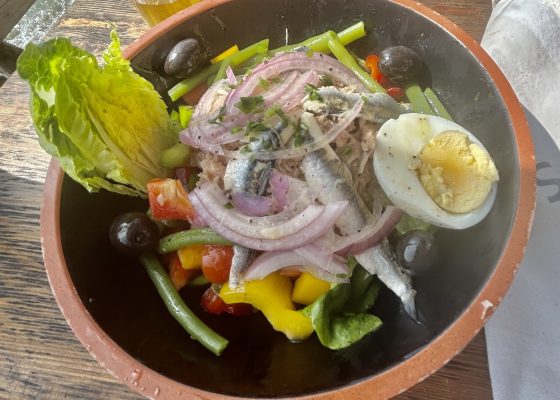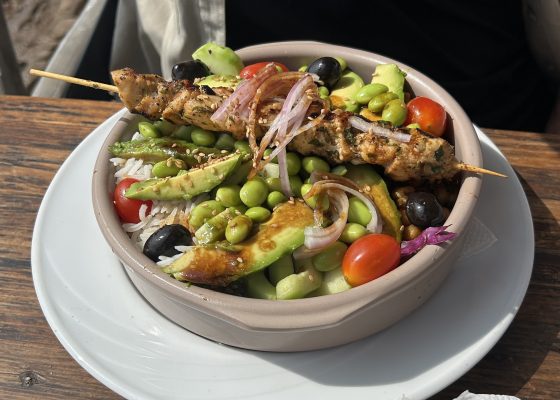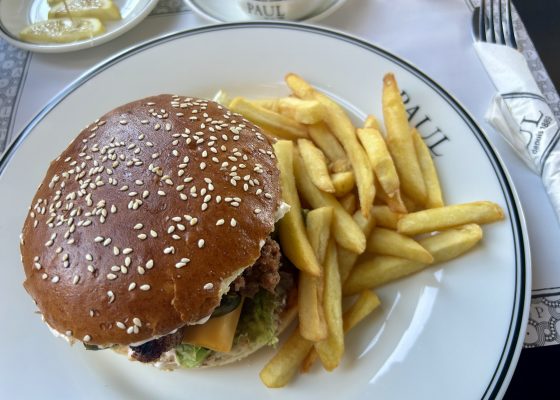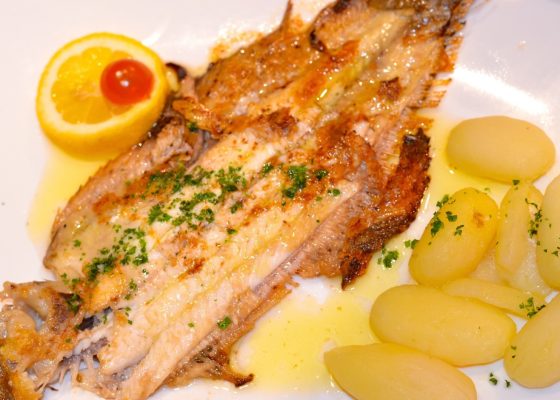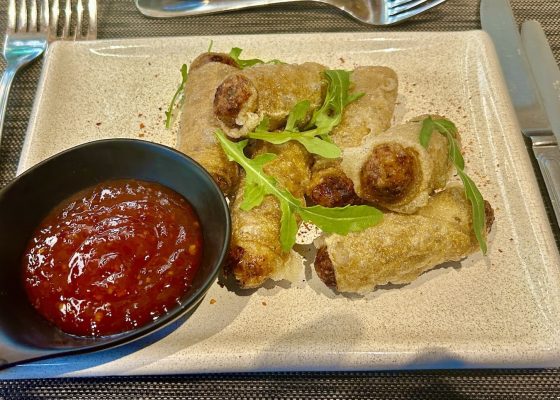Morocco with Adventures Abroad
Alison and I are decompressing at the Eden Andalou resort just outside of Marrakech after a hectic and very exciting 17 day tour of Morocco with Adventures Abroad. As with all our Adventures Abroad trips I will start off with an overview post which I hope will give the reader a fair assessment of whether or not Morocco is the right destination for you. Some of my my recent overviews have come from New Zealand, Chile and French Polynesia and all were stellar destinations made even better by the presence of veteran guides Chris Tripodi and Martin Charlton.
In keeping with this tradition of excellence, the Morocco trip was enhanced considerably by the guidance of Laura Carballo who was ably assisted by George Alexander.
So let’s do a deeper dive into what Morocco has to offer and some of the things you need to be aware of before booking this trip.
First of all, why Morocco?
Cliche alert – Morocco has a rich history, diverse landscapes, friendly people and a chance to ride a camel. Well so do lot’s of other places as well, but what sets Morocco aside from these other places? First of all, it is an Arabic country with Islam as the dominant, if practically, the only religion. Many westerners are leery of venturing to an Islamic nation, mainly because of stereotypes that plague the media, both traditional and social. Morocco is a fairly liberal and while technically not a secular state, is for all intents and purposes a free and open society that is welcoming of non-Islamic tourists from around the world. Morocco would be my country of choice for a first time visit to an Arabic Muslim country.
Setting aside any thoughts of religion or ethnicity, Morocco, situated as it is in the northwest corner of Africa, has its feet planted firmly on the Mediterranean, Atlantic and in the Sahara Desert. While the Adventures Abroad tour does not venture to the Mediterranean shores of Morocco, it does explore the Atlantic and Saharan regions of the country and everything in between. If you’ve always wanted to see and experience the Sahara Desert, and who doesn’t, Morocco is a great place to do it.
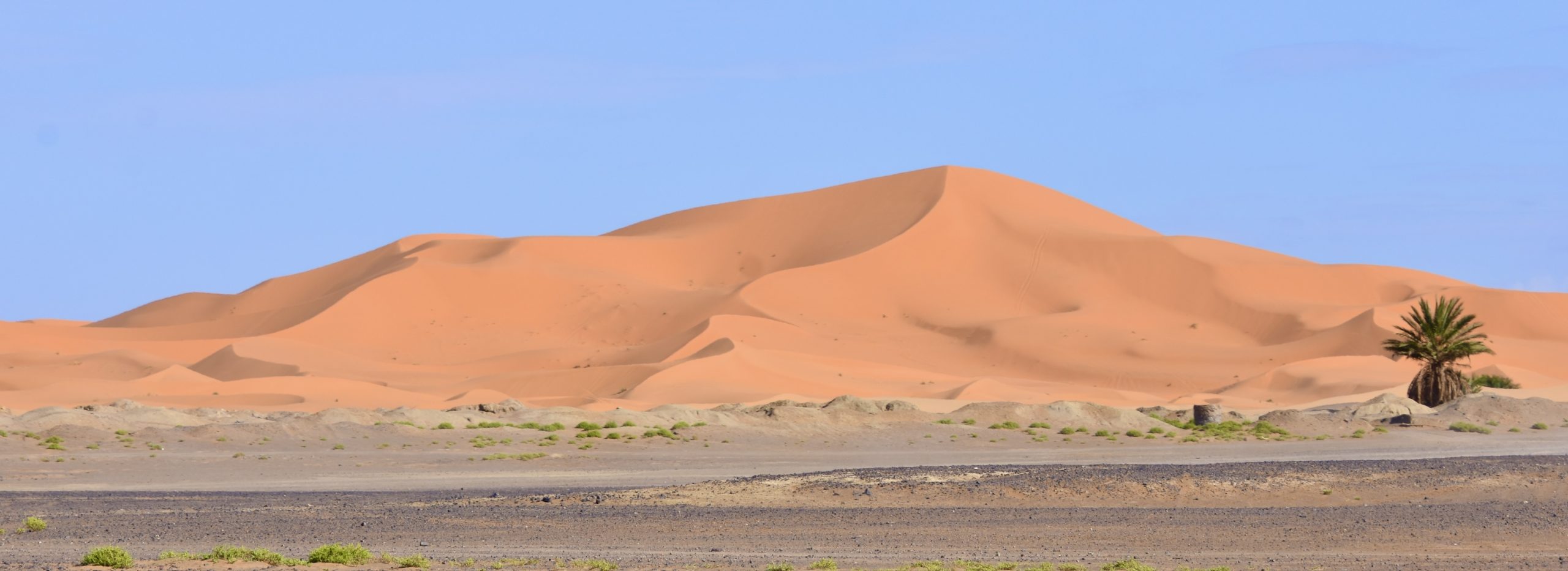
While exploring the Moroccan Sahara, you’ll also discover the true meaning of an oasis. In western literature and movies they are always portrayed as small patches of green in the middle of nowhere, when in reality they are huge swathes of palm trees stretching for miles atop underground rivers the waters of which rarely reach the surface. Morocco is home to the Tafilalet oasis, at 77,000 sq. km. the largest in all of the Sahara and one that you will explore for several days on this tour.
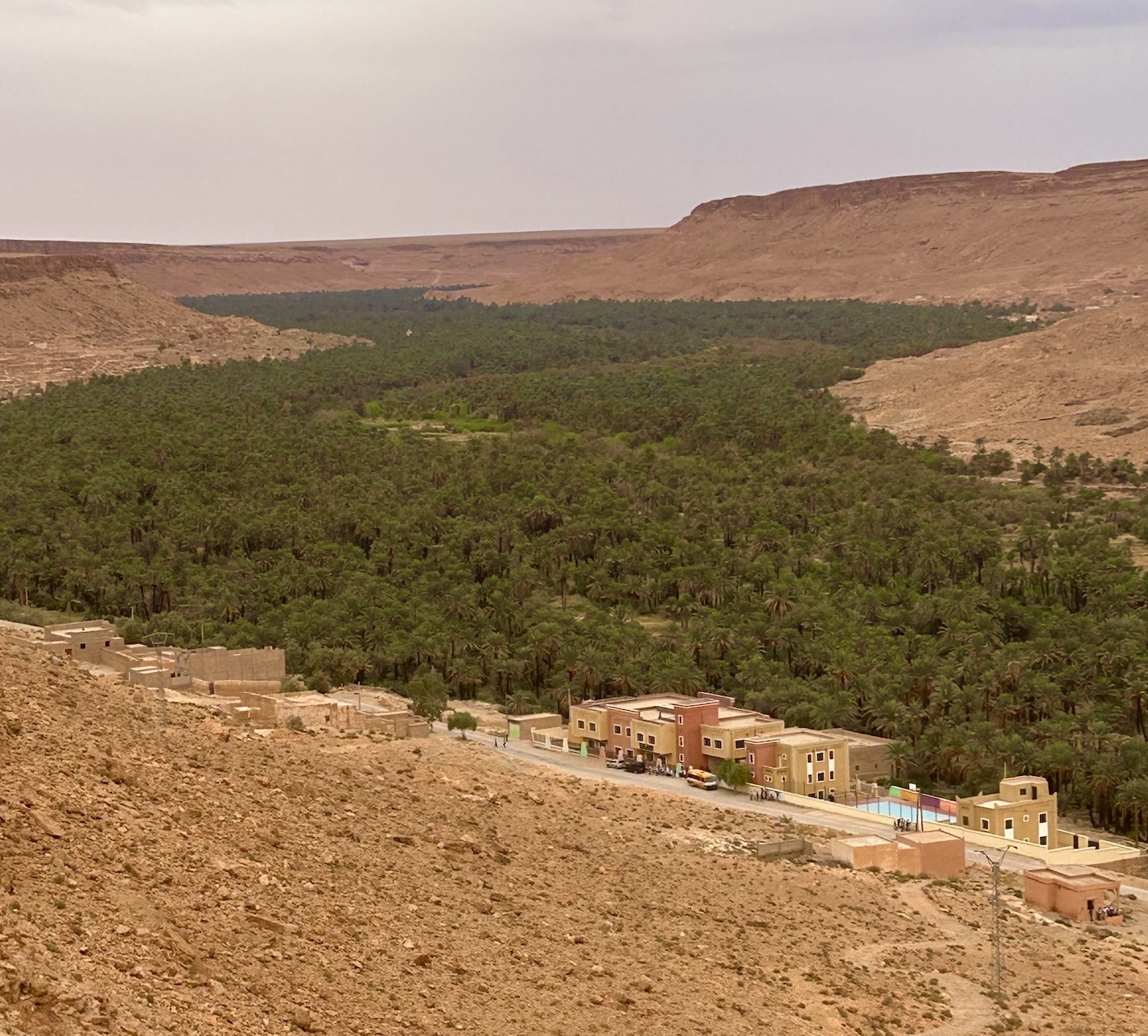
With a written history that goes back to 1,000 BCE with the arrival of the Phoenicians to the Mediterranean and later Atlantic coasts, Morocco has gone through a number of distinct historical epochs, all of which have left their mark on the country today. The Romans succeeded the Phoenicians and lasted some four centuries before the Empire collapsed and was followed by brief periods of Vandal and Byzantine occupation. The most important historical event in Moroccan history was the coming of the Arab invasion of 681 and with it the religion of Islam. Prior to this invasion the vast majority of the population were Berbers who one might consider the Indigenous peoples of Morocco. After the invasion the Arabic population became the majority with today the split basically two thirds Arab and one-third Berber, although there are a lot of mixed descendants.
The first Arab dynasty, the Idrissids were based in Fes and went on not only to conquer and convert Morocco, but also most of Spain as well, where they established Andalusia. For more insight into Andalusia read my posts on Cordoba and the Alhambra. Just as powerful medieval European families were constantly attempting to increase their territory and influence, so to the Islamic families in Morocco. In the 11th century the Berber Almoravid dynasty seized power and founded the city of Marrakech as their capital. They lasted about a century until the Almohads took over in both Morocco and Andalusia before losing control to the Marinids who held power until the 15th century. After a century of internal strife the final Moroccan dynasty, the Alaouites, emerged victorious and since that time have ruled the country ever since, with one brief interregnum. Early in their reign, Moulay Ismail established Meknes as the capital during his long rule, making it the third of four Moroccan capital cities, all of which you will visit on this tour.
Now I really don’t expect the reader to memorize the names of these various dynasties, but only mention them because their names will appear time and again on visits to the cities they ruled and other places associated with them.
The interregnum occurred from 1912 to 1956 France when forcibly occupied Morocco under the guise of a Protectorate, a common colonial ruse for seizing power from a legitimate government. Although the period of occupation was historically short, the French influence was profound. Today it is the language of communication for many. It was the French who moved the capital to Rabat where it remains today.
In 1956 the French left and since then Morocco has been fully independent with a ruling monarch who, while not omnipotent, has powers that other reigning monarchs can only dream of. The upside of this is that, since independence, the monarchs have been intent on modernizing the country. It has the fifth largest economy in Africa and one of the highest standards of living, but that’s a relative thing. There are still are millions of abject poor and modern infrastructure is almost non-existent in places. The Adventures Abroad local guides do not minimize the problems that Morocco faces today, while emphasizing the things that are going well, including the booming tourist industry.
World Heritage Sites
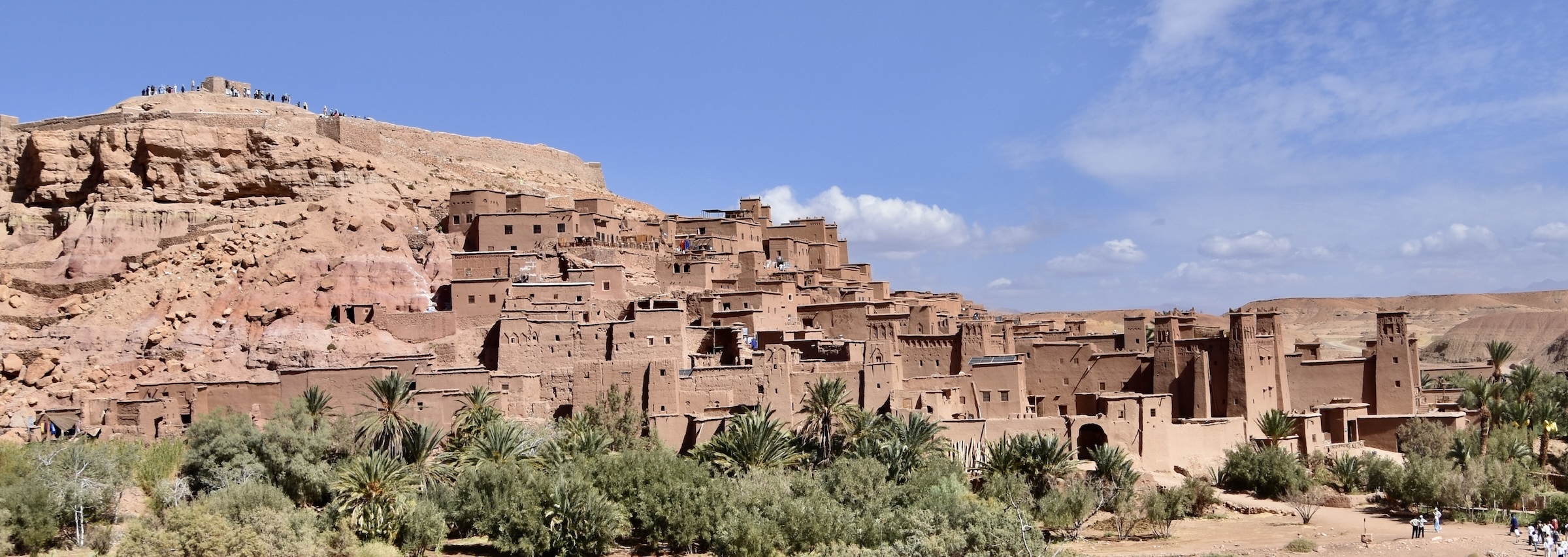
So with this history going back so far and so many different dynasties contributing to it, it is not surprising that Morocco has a plethora of UNESCO World Heritage Sites, seven of which are visited on the AA tour. I won’t list them here, but each will feature in a future post. Some include names that are exemplars of the exotic like Marrakech, Fes and Meknes while others like Ait Benhaddou shown above are lesser known. For all World Heritage Site seekers, of which I am one, Morocco has to be on your list.
Speaking of exotic, Morocco has a combination of architecture, local dress, sights, sounds and aromas that is like nowhere else on earth. Whether it’s the pandemonium of the Jemaa el-Fnaa (main square) in Marrakech or the quiet confines of a kasbah Morocco will astonish you. BTW you’ll learn the difference between a kasbah, a ksar, a souk, a medina and a bazaar on this trip.
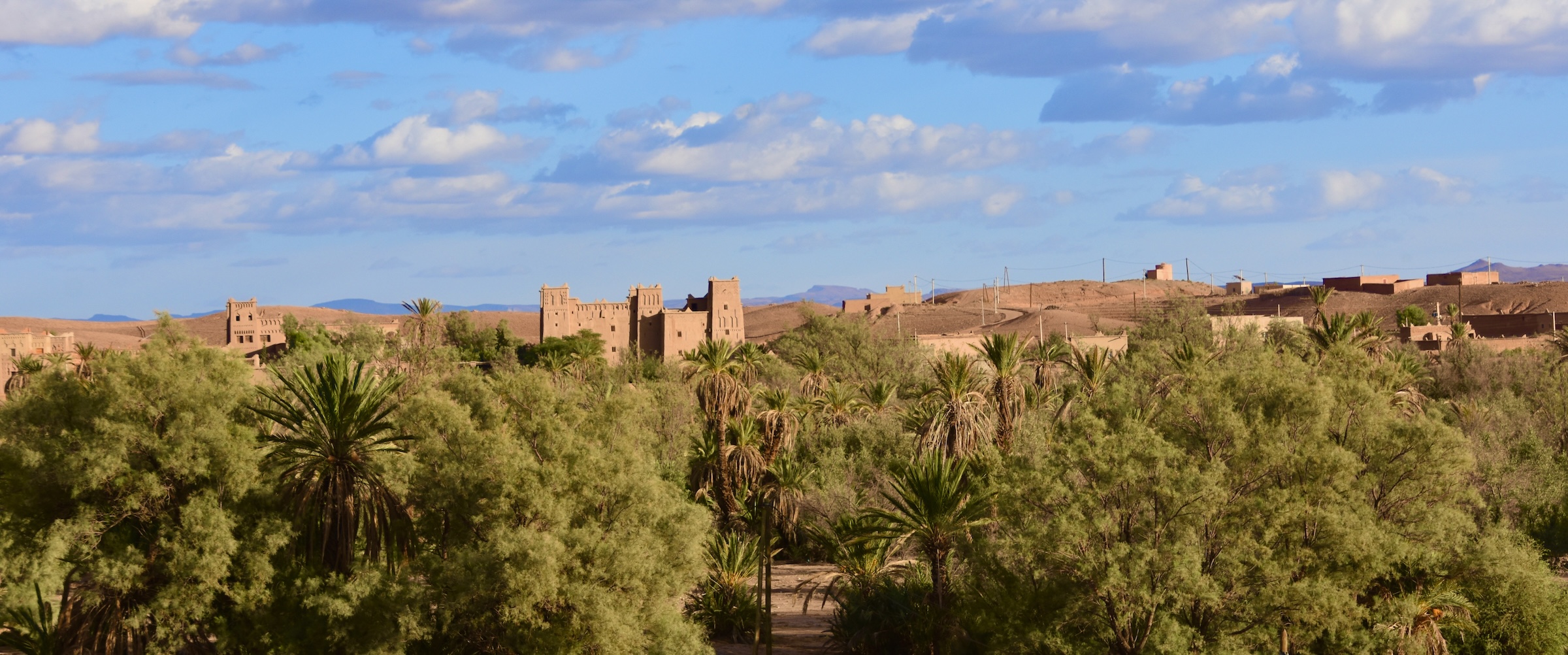
Tell me this is not what you have seen in countless movies, but never in person. Alison and I loved these desert structures built only of mud, straw and water.
Some Moroccan Highlights
This post could go on forever if I tried to cram everything into one post so I’m just going to focus on a view highlights that I hope will be enough to convince you to you must see and experience them as well.
- Fes Medina – This is one of the best preserved Arabic cities in the world and also one of the world’s largest pedestrian zones. The Fes medina is a walled city within which 100,000 people still live and ply their trades. Unlike many medinas, say for example Casablanca’s, Fes is not a tourist trap, but the real deal. While it is choked with tourists, they are here to see and experience a way of life that is so completely different from anything western that it is mind boggling. I will describe this medina much further in a full post, but trust me it will be a highlight of your visit to Morocco.
- Volubilis – I am an admitted Romanophile and the ruins of the city of Volubilis are an outstanding example of a small Roman provincial city complete with some of the best mosaics you’ll find anywhere.
- The Sahara – Seeing the grand dunes of the northern Sahara from the back of a camel and then ascending one to watch the sunset is something that will create live long memories.
- The Madness of Marrakech – The Jemaa el-Fnaa or grand square of Marrakech has to be seen and heard to be believed. Packed with tourists and locals you will see every variety and colour of local dress, snake charmers, acrobats, dozens of food stalls and a whole lot more. It’s not for everybody, but I wouldn’t have missed it for the world.
- Essaoiur – This city on the Atlantic coast was easily my favourite in Morocco. The medina was laid out by a French architect in the 18th century and has a far less claustrophobic feel than most others. The sea breeze was a welcome complement to the atmosphere after days in the dusty desert.
- Atlas Studios – The largest film studio in Africa has seen many of the world’s favourite movies shot here and the tour of the sets was an unexpected pleasure highlighted by a really interesting guide who took some very interesting videos that I’ll feature in an upcoming post.
Why Adventures Abroad?
Okay, I hope I’ve convinced you that Morocco is a must visit destination, now let’s turn to why I think Adventures Abroad is the tour company to take you there.
Let’s start with some brutal honesty about Morocco; it is on the verge of being over touristed and in places already is. I was quite surprised at just how many tourists there were, almost everywhere we went. The great majority were European with a few Asian and even less so North American. Only a very brave or foolhardy soul would consider visiting Morocco on their own. Driving in the old parts of the cities is near suicidal and the risk of getting lost in a medina is not a joke. So you need to go on a group tour.
You also need to realize that the medinas in Fes, Meknes and Marrakech are rabbit warrens that in places are so narrow that two people can barely pass each other. Now imagine being in a 40, 60 or even 80 person tour and trying to follow one person through these labyrinths? We encountered group after group like this and it was nuts. Our group was limited to 17 and even that at times had its limits. So you need to go in a small group.
As I noted, there were not many North American tour groups that we encountered and certainly no other Canadian based ones. Adventures Abroad appeals specifically to Canadian and Americans, most of whom are well travelled and well educated. In my experience the groups tend to get along very well and often life long friendships come out of these tours and this one was no different. Our group consisted of 15 Canadians and two Americans which was a bit different from the usual 50/50 split. I’ll leave you to guess why this one was different. I can tell you that our American friends were treated as family and I think would say they felt right at home with the rest of us.
One of the things that Adventures Abroad relies up heavily is the use of local guides and nowhere was this more evident than on this trip where I think we had at least ten if not more. All spoke decent English or better and knew their stuff. While we did get some repetition that was better than not getting enough info. All told the local guides were a big part of the success of this trip.
We had the good fortune to have two tour guides on this trip with Laura Carballo, a native of Sevilla Spain who lived in Morocco for a number of years as our chief guide. Laura is a funny, intelligent and warm leader who helped us through what was in some respects a difficult trip with a higher than normal number of cases of illness.
This is Laura with 92 year old Elisha from Chicago who she shepherded through the trip like a daughter. BTW Despite her age Elisha kept up with us every step of the way.
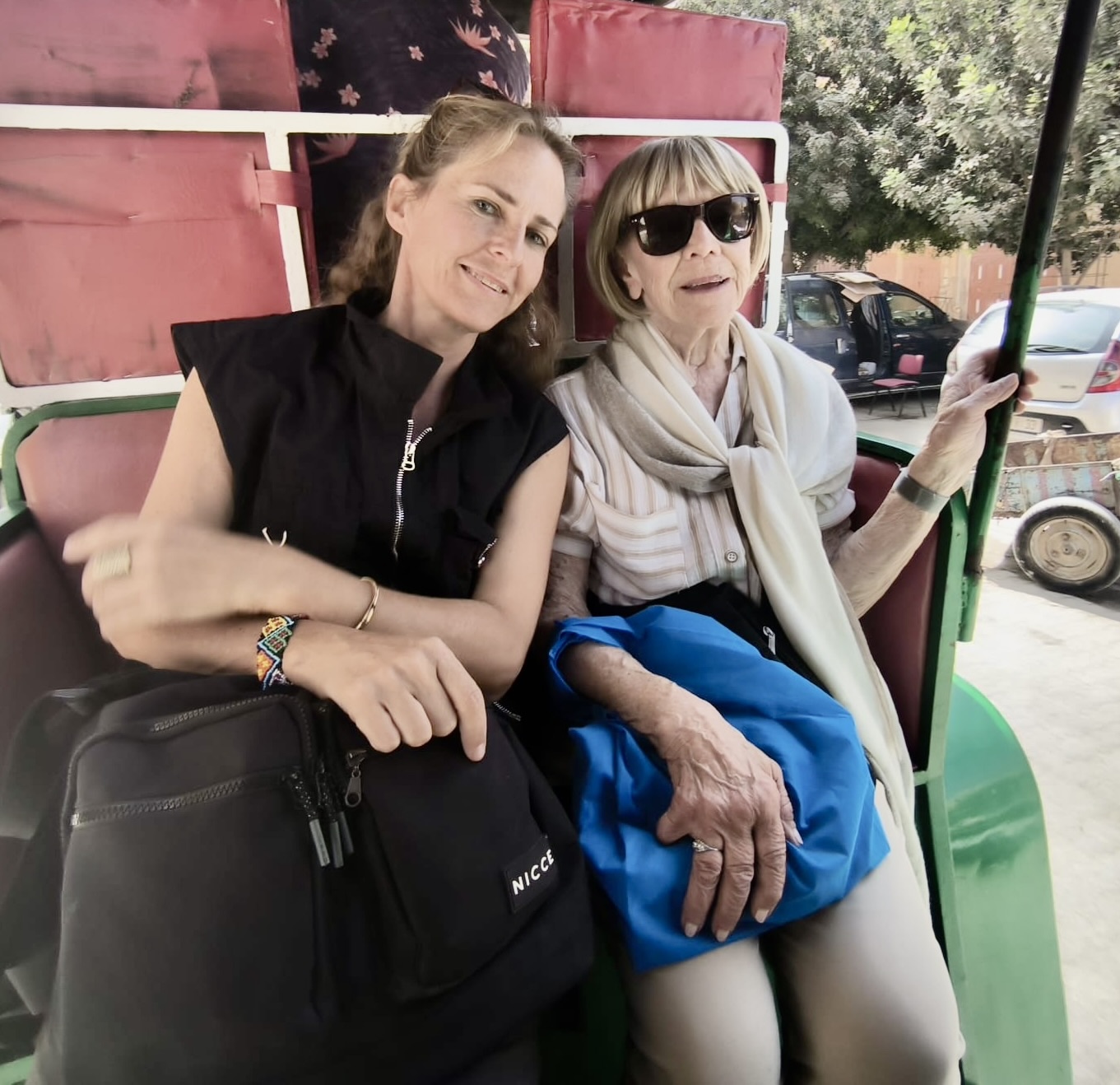
George Alexander is one of Adventures Abroad’s most recent hires and after leading tours to the Caucasus had some time off and opted to join the Morocco tour as a most able wing man. Soon tagged “Glorious George” by some of our fellow travellers George proved very necessary as the trailer in our forays through the medinas where losing somebody was not an option.
This is George sharing a communal meal in an apple orchard with three of the ladies. Not surprisingly there’s not much left on George’s plate.
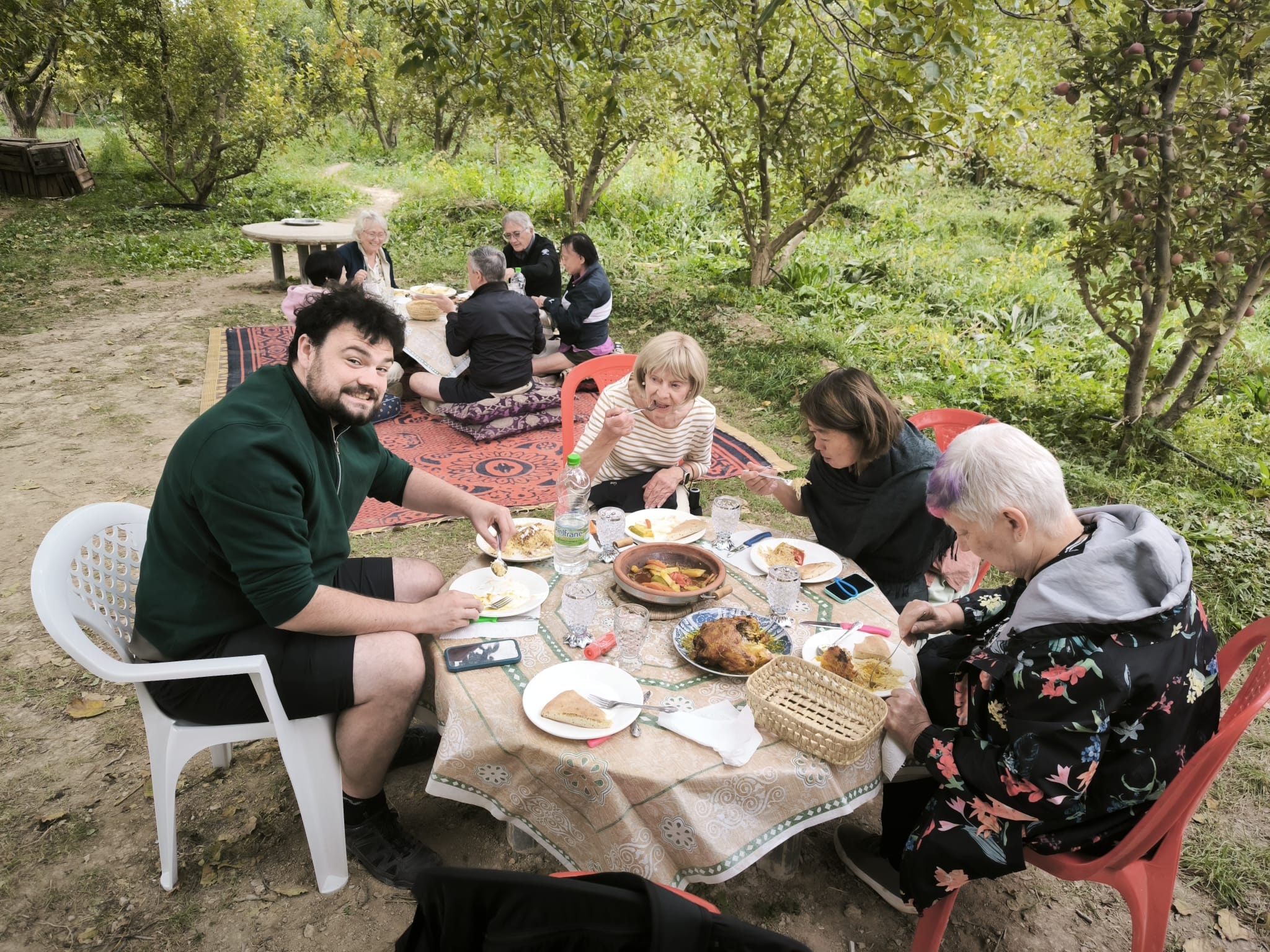
The final member of our team was Hassan the very competent and cautious bus driver. Driving in Morocco is not really a problem outside the cities, but within them is very challenging with suicidal motorcycle drivers cutting in front and forcing extreme caution on the driver’s part which Hassan handled with aplomb.
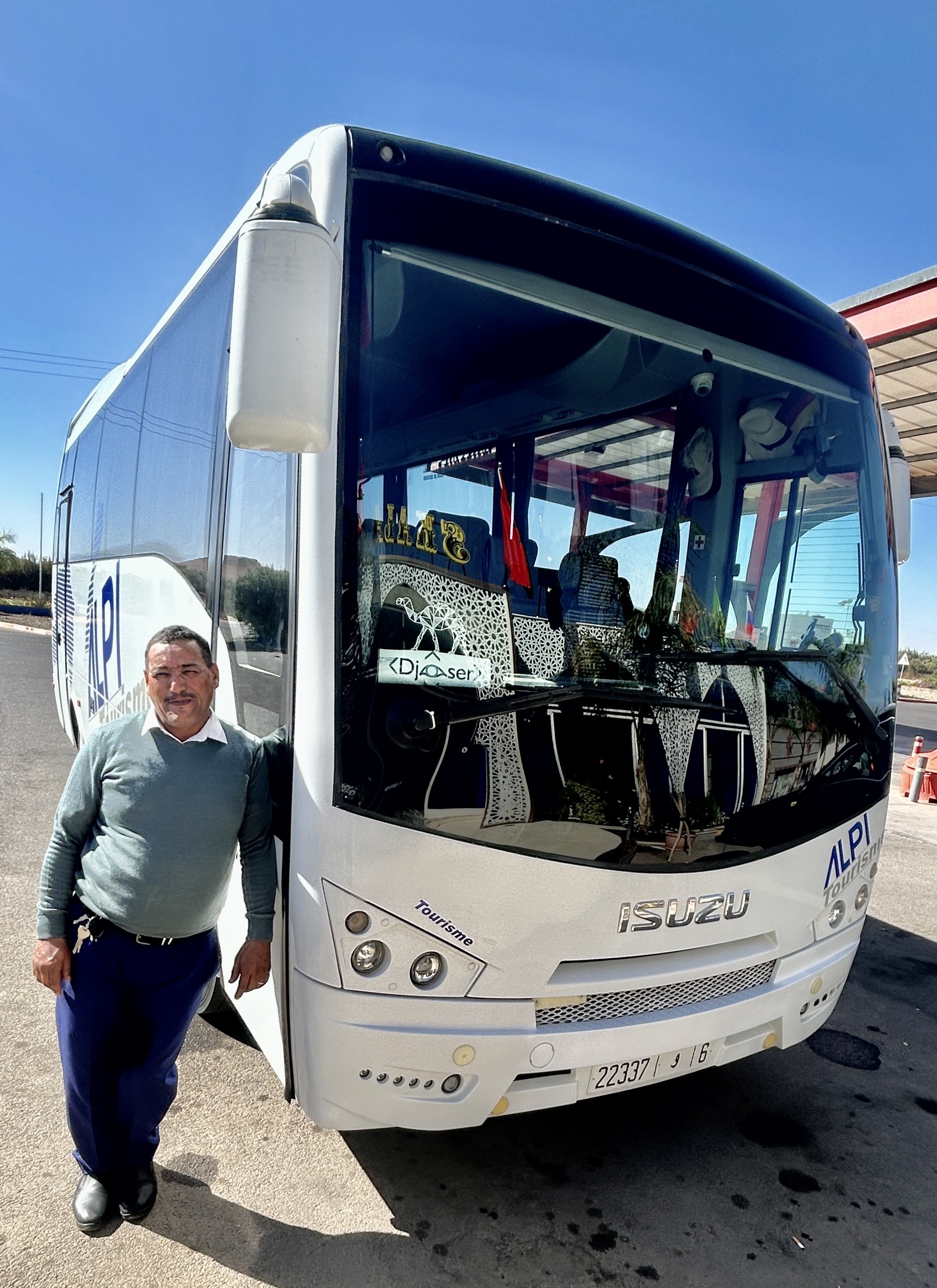
Our bus had about 36 seats so there was lots of room for everyone and their luggage and as an added bonus there was on board wifi that actually worked most of the time.
Health and Safety
No let’s talk about some practical issues. Morocco is not a country where you need to worry about serious diseases like malaria, yellow fever or cholera. But you do need to be very careful about what you eat and drink. Don’t expect it, but be prepared for traveller’s diarrhea. Try to avoid it by shunning uncooked vegetables, unpared fruit and undercooked meat, but even that might not be enough.
In terms of personal safety, I’d rather be walking around anywhere in Morocco at night than dozens of places I can think of in North America and Europe. Islam puts a high premium on honesty with the result that theft and robbery are virtually non-existent. One of the things I really appreciated about Morocco is that the vendors at the souks don’t hassle you like they do in Turkiye, Egypt, India etc. Going to a bazaar in Turkiye is a shitty experience because of the constant haranguing and smoke in the air. In Morocco you can look at something without setting off a bargaining session. We’ve all seen adds showing tourists having a wonderful time admiring the bright colours and handicrafts on display without being hassled. The closest I’ve ever come to that is in Morocco.
I have seen posts on the internet saying to avoid Morocco because of the harassment, scams and other unpleasantries, but honestly that was not the Morocco I saw. Maybe it was usually being in the presence of a local guide, I don’t know.
Bargaining is the order of the day in Morocco and there are great deals to be had on leather goods, ceramics, fabrics and metalwork as well as spices and argan oil which is a Moroccan specialty. Laura was a great help in assisting the group with finding the best places to buy specific items at the best prices.
Food & Drink
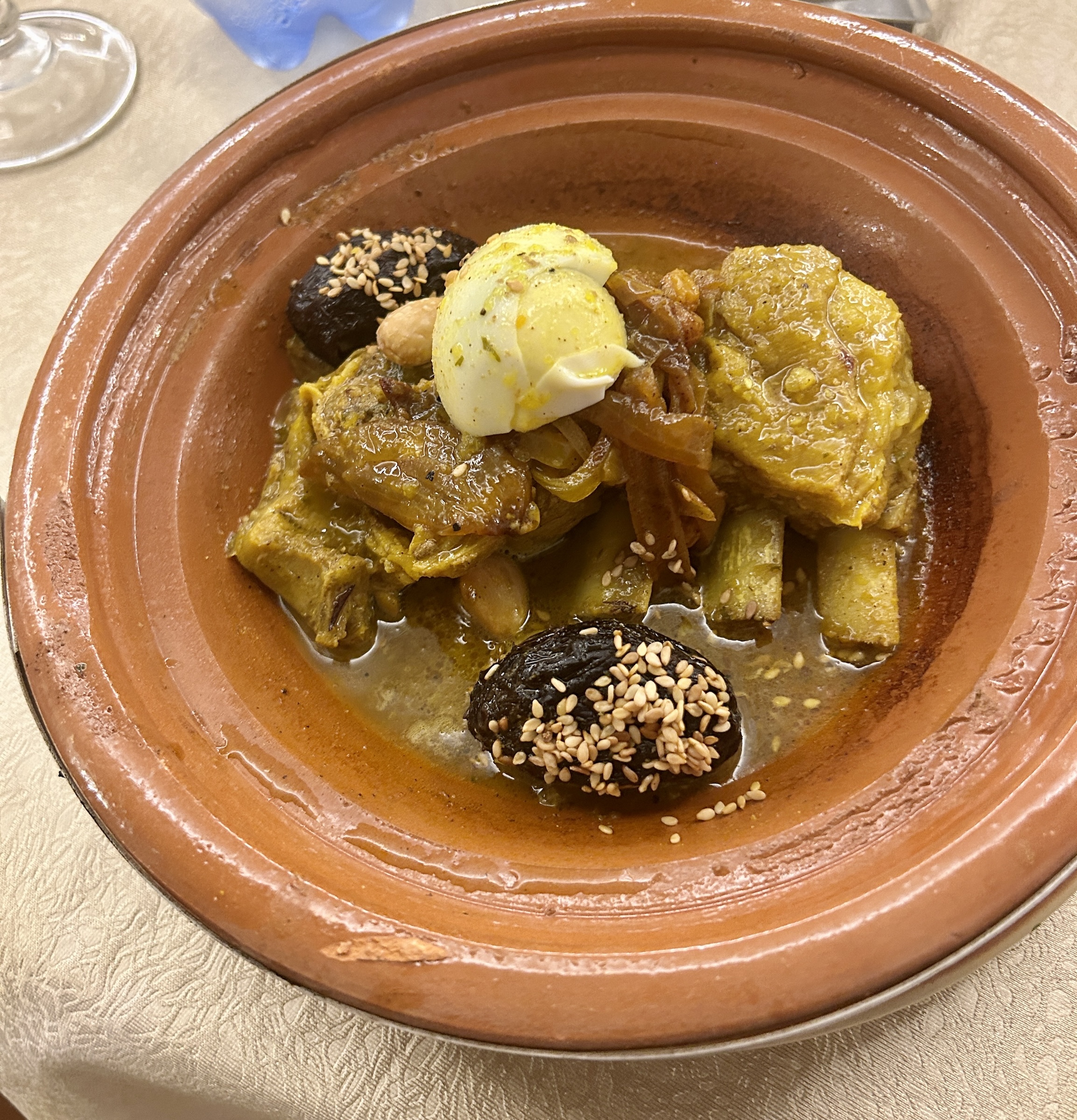
If you go on the internet and ask why you should visit Morocco one thing will inevitably come up – the food. In fact a number of sites identify it as the #1 reason to visit, claiming it uses ingredients similar to that of Spain, Italy and Greece. Sorry, that’s BS. All of those countries, especially Spain incorporate pork, the most versatile of meats, into their cuisine. They also use alcohol in cooking and as a complement to the meal. And they are all crazy about cheese. None of these things are true about Moroccan food.
I must admit that Moroccan cuisine has a higher reputation in North America than it deserves on the ground in Morocco. The reason I say that is that there is a total lack of variety. Every menu has three types of tagine (which are very good, but you can’t eat them for 17 straight days), several types of couscous, usually too dry and maybe if you’re lucky a pastilla. Add in the traditional harira soup which again is okay, but not in the same league as many other national soups, a few salads and that’s about it. Time and again.
Some places have pizza and burgers (George was very thankful for that).
While the French left the Moroccans with a taste for good pastry, unfortunately they forgot to tell them how to make it properly. Most pastries, while looking like the real deal, were dry and tasteless.
Breakfasts are very simple with several types of pancakes or crepes being the staple, yogurt and not much more. I’m not a breakfast guy so it was not a big deal. Green tea is omnipresent and the coffee was hit or miss.
To be fair there are some very good Moroccan desserts many involving phyllo pastry.
Here is a gallery of some of the Moroccan and non-Moroccan dishes we sampled on this tour. Double click to open and double click again to enlarge.
- Lamb Tagine
- Minced Meat Crepe
- Berber Omelet
- Dessert Pastilla
- Lamb Couscous
- Apple Orchard Feast
- Sefra
- Nicoise Salad
- Buddha Bowl
- Proper Burger, Paul Restaurant, Marrakech
- Sole Meuniere
- Spring Rolls,
What really surprised me about Morocco was how difficult it was to get alcohol. I assumed it would be like Turkiye where beer and wine are widely available and liquor in the tabac shops. Not so here. Liquor is only available in a few large supermarkets on the edge of cities. Laura stopped at the Carrefore in Fes so we could stock up. Other than that you cannot get a beer for lunch anywhere that is inside a medina. Wine for dinner was only available at a few places we stayed which was unfortunate because Moroccan wines are pretty good.
So if you are used to having alcohol with you food forget about it in Morocco. I never drank so much water in my life.
Accommodations
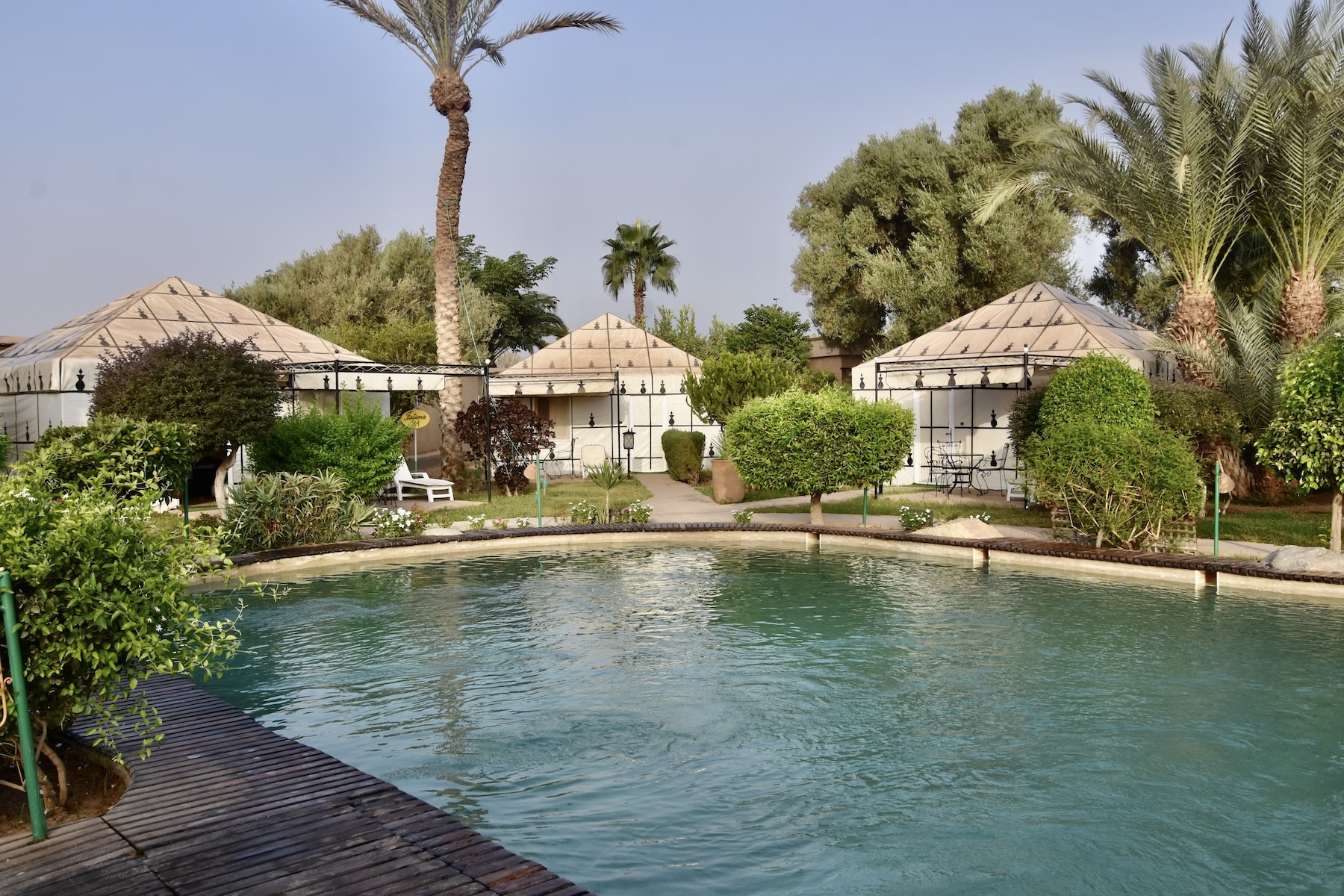
Adventures Abroad usually features a different variety of accommodations depending upon the country visited. There is pretty well always one over the top spot which in this case was the fabulous Dar Zitoune in Taroudant which had great rooms, very nice grounds and an excellent restaurant that featured a different menu each night.
The most typical of Moroccan accommodation choices is the riad which is something equivalent to an inn based in what were once grand family homes within the walls of a medina. These all have a central court with a fountain and sometimes a pool around which various rooms are laid out on the upper floors. We stayed in riads in Fes, Essaouir and Marrakech. All were fine, but the rooms tend to be quite small. Here is a typical example.
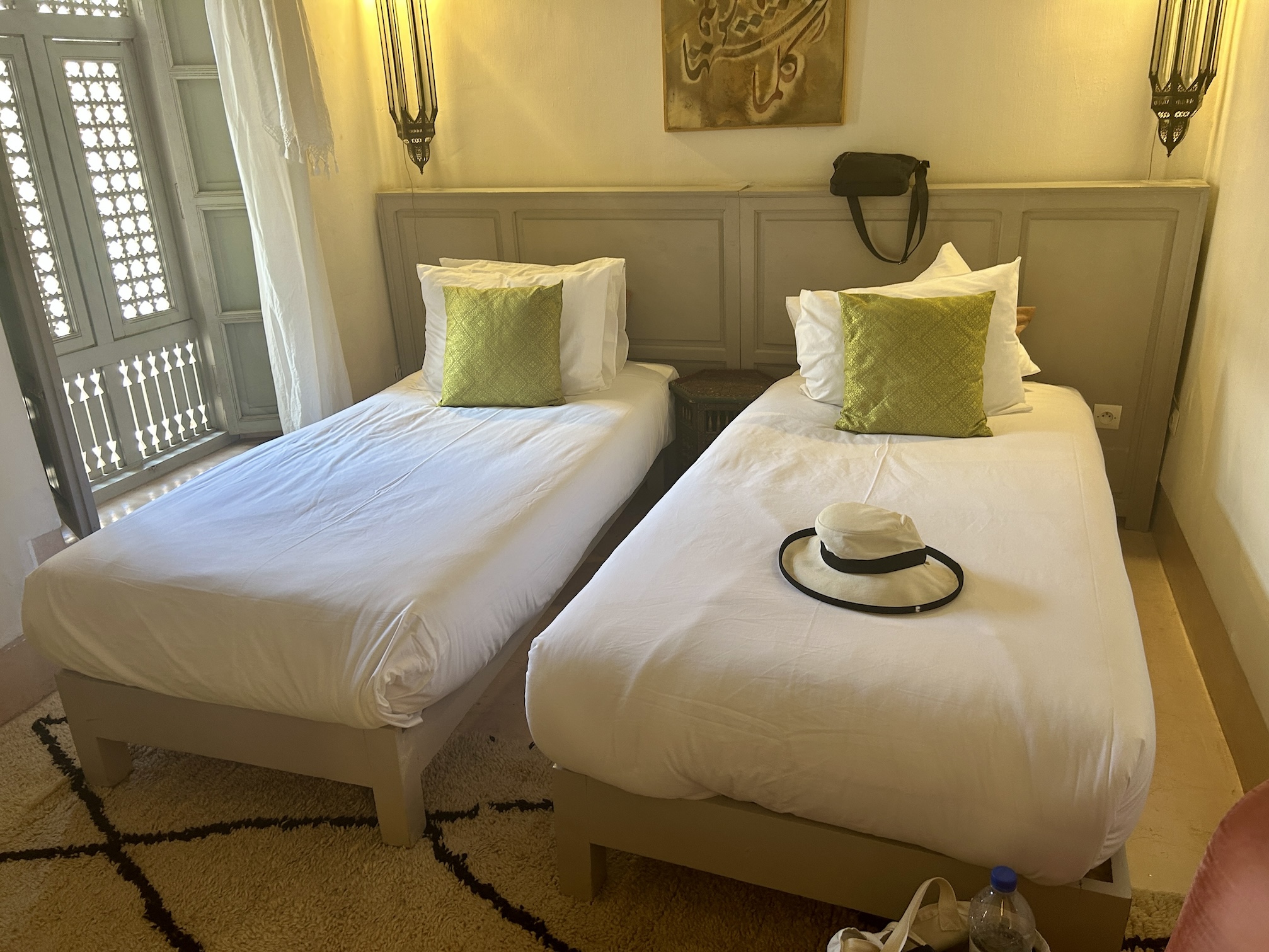
Generally most rooms did not have a fridge and in some cases a TV, although I don’t think we turned one on once during this tour. The bathrooms are small as well, but you don’t have to put the used toilet paper in a basket like in some places. All of the riads were clean to a fault.
The other type of Moroccan accommodation that is quite unique are the kasbahs. These are stand alone fortified buildings that were once also family or clan homes. We stayed in three kasbahs or at least imitation kasbahs and they were quite a bit more spacious with nice grounds. The Xaluca in Erfoud was especially nice with an excellent restaurant.
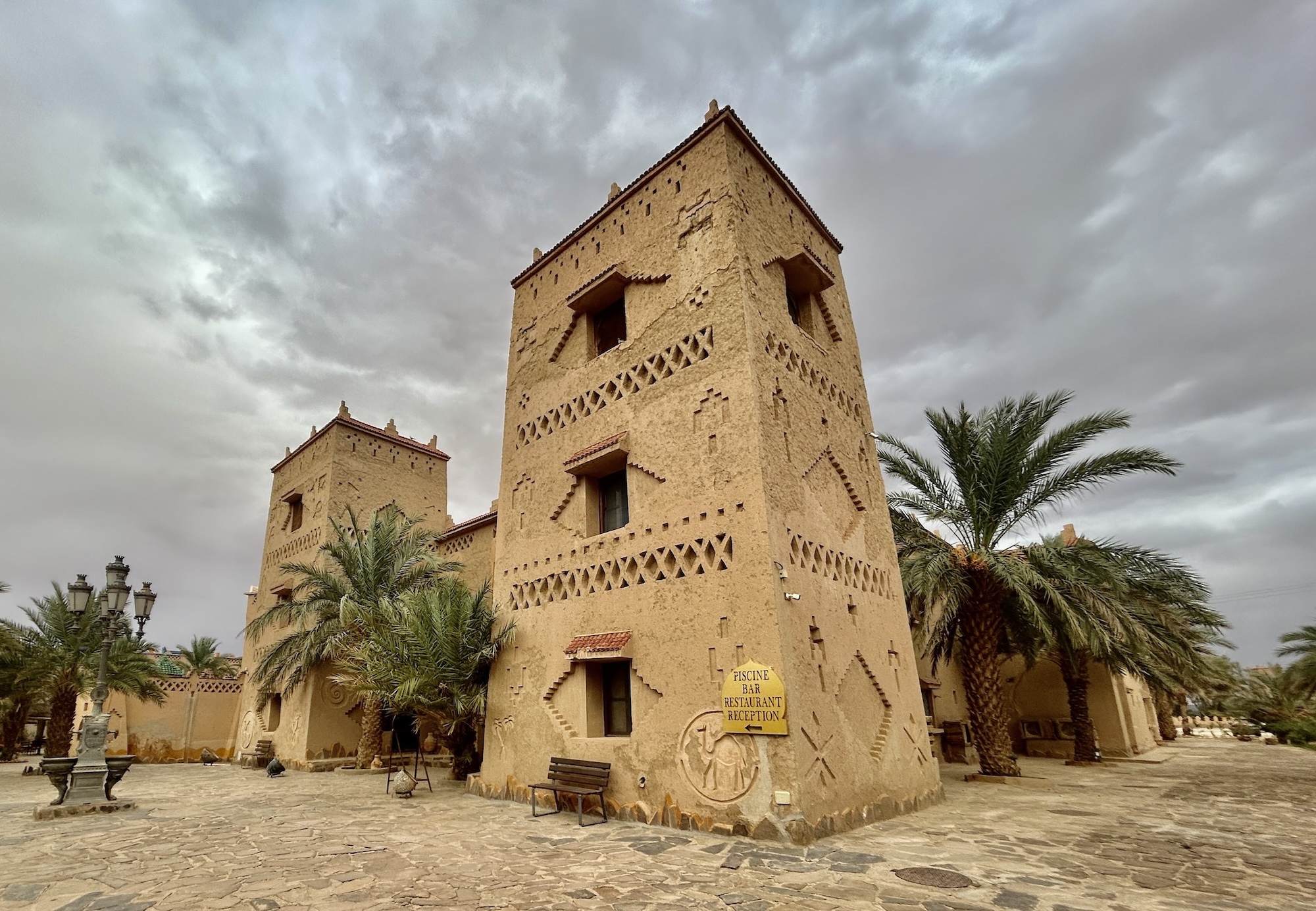
Overall the accommodations were more than adequate and in some cases outstanding.
Some Final Tips
For the past few years e-sims have become very popular with traditional sims falling by the wayside. I’m glad to say that tradition has caught up. The problem with e-sims is that while you get texts and data you can’t make calls with them – people were using What’s App for those. Now for almost the same price as an e-sim you can get a traditional sim card installed that will give you not only calling, texts and data, but also redirect calls and texts to your North American cell to the Moroccan number. This is a pretty big leap forward. What I found really important was having Google or Apple maps always available. Even in the most narrow parts of a medina they were able to guide me to where I wanted to go without a hitch. Those with e-sims had problems. So my advice is get a real sim card like you used to. They are dirt cheap compared to the insanely expensive Canadian roaming charges.
Lastly, make sure you have What’s App installed on your phone. Almost all tour leaders use it to communicate with their charges. Laura used it expertly and it was the perfect forum for exchanging photos, finding people who got lost (only happened once) and making changes to schedules.
So that’s it for this first post from Morocco. In the next one we’ll see what Casablanca and Rabat have to offer.


